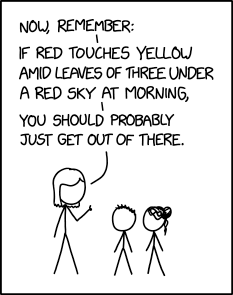Danger Mnemonic

It's definitely not the time to try drinking beer before liquor.

It's definitely not the time to try drinking beer before liquor.
The teacher Miss Lenhart warns two small kids using a danger mnemonic. However, this is actually a mash-up of three different common danger mnemonics, each of which warn about different hazards. Combining all three sayings sounds particularly ominous. It implies that a person is involved with a situation simultaneously involving coral snakes, poison ivy, and potentially nasty weather. In such a case, Miss Lenhart advises the children to "just get out of there", implying that the situation is too dangerous to try to deal with. See also 2422: Vaccine Ordering for the previous time xkcd referenced the latter mnemonic and 2038: Hazard Symbol for another combination of danger warnings.
- Red touches black, that's a friend of Jack; red touches yellow, you're a dead fellow.
- This mnemonic is intended to help recognize venomous coral snakes, which have brightly colored stripes. Some nonvenomous king snake species have similar striped colors, but in different patterns. Note that this mnemonic is not accurate, especially outside the eastern United States where it was originally created, as many species of coral snake have black stripes touching red stripes, and if the snake has atypical coloration, then the rhyme may still lead to misidentification even in the right region. The safest course of action is to avoid any snake with the warning colors of red, yellow/white, and black stripes. Another corruption of the same warning features in 1604: Snakes.
- Leaves of three, leave them be; berries white, poisonous sight. (or "run in fright" or "hide from sight")
- This mnemonic is used to identify poison ivy and poison oak throughout much of North America. These plants both produce an oily surface resin called urushiol, which causes an allergic reaction in the majority of people. Touching either plant can result in contact dermatitis, which can be severely itchy or painful. If burned, the urushiol can be inhaled, causing lung irritation. While rarely serious, these reactions are often severely unpleasant and can last for weeks, so avoiding the plants is well advised. Both plants generally grow three leaves at the end of each branch, and grow berries that turn white when ripe. The mnemonic helps in remembering this characteristic to distinguish them from similar-looking but harmless vines. See 443: Know Your Vines.
- Red sky at night, sailor's delight; red sky in the morning, sailors take warning.
- This mnemonic predicts bad/good weather conditions based on a particularly red sunrise/sunset. It is predictive at middle latitudes where the prevailing winds go from west to east. Regions of higher air pressure will cause a particularly red sky at sunrise/sunset, so a red sky in the evening indicates a high pressure system is coming in from the west with its calmer weather, while a red sky in the morning indicates a low pressure front coming in (usually with rain and rougher weather). In some countries (such as the United Kingdom), the saying mentions shepherds rather than sailors. Randall actually wrote a newspaper article explaining this phenomenon.
- Beer before liquor, never been sicker; liquor before beer, you're in the clear.
- The title text refers to another mnemonic. Unlike the first three mnemonics, which are genuinely useful for avoiding danger, this one is largely a myth, as the order in which you drink alcohol is unlikely to impact how sick you become. However, whether the mnemonic is true or not, testing it would involve multiple drinks of alcohol, which would be ill-advised when facing a dangerous situation, particularly one as bizarre and complex as implied in this strip.